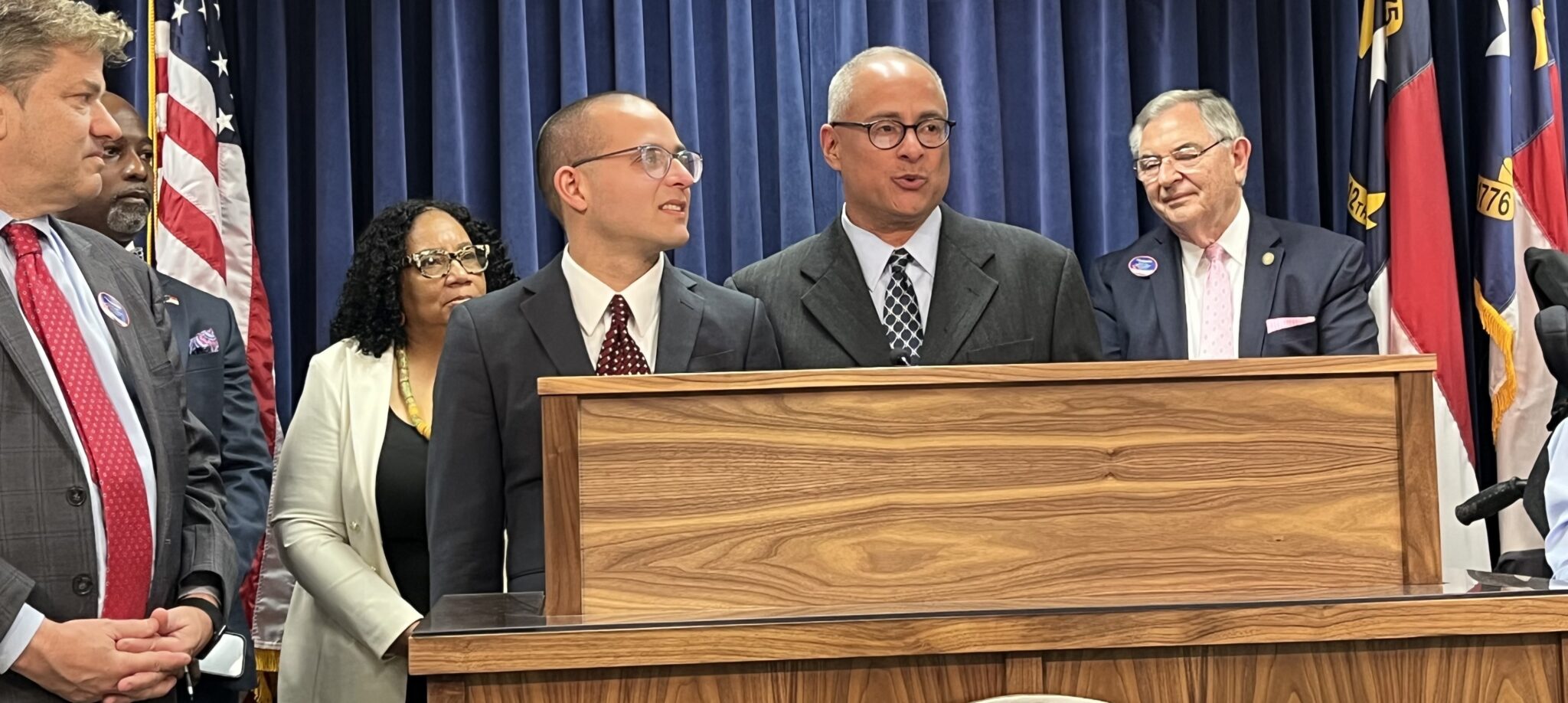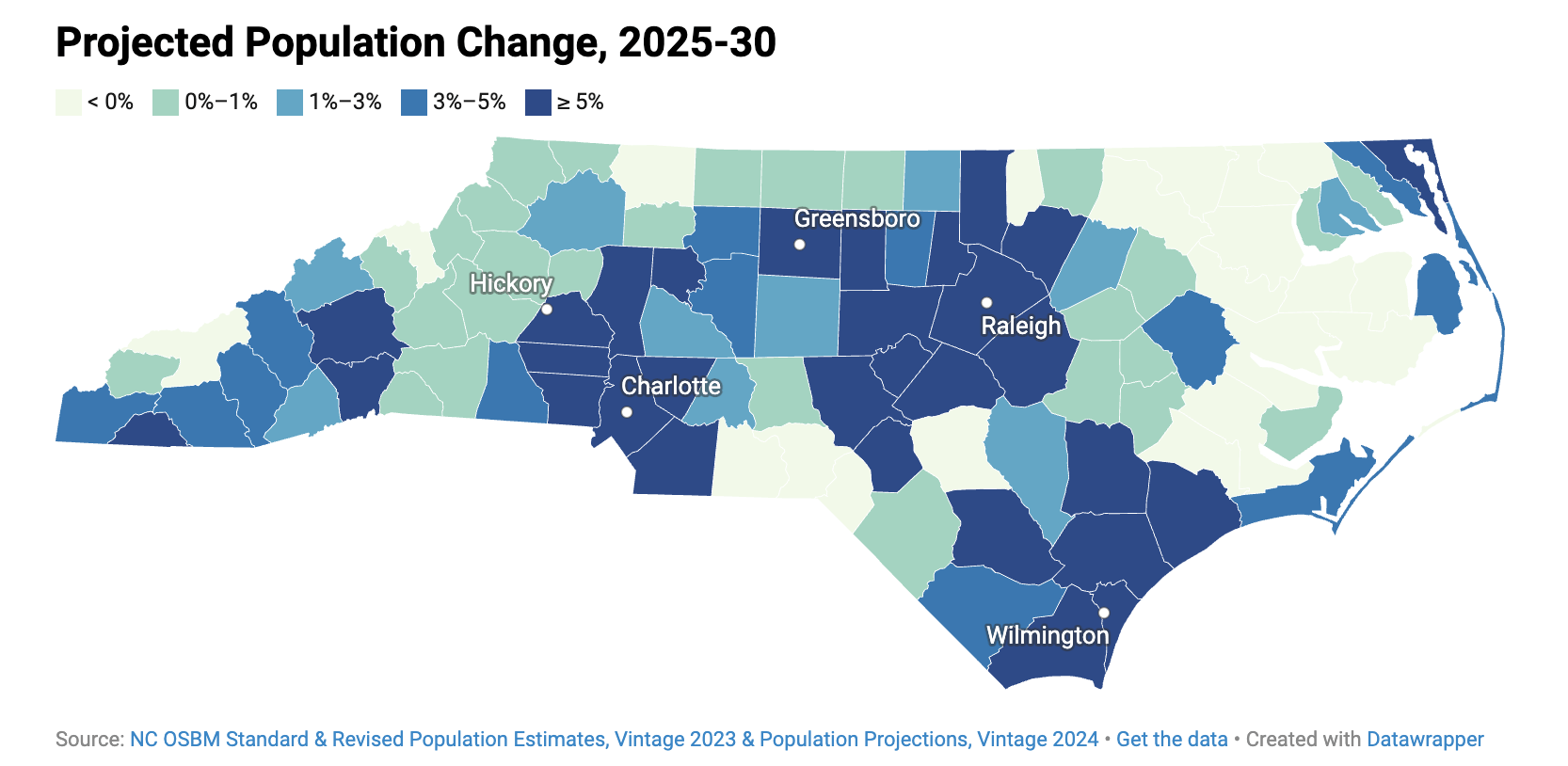Disability advocates, families push N.C. lawmakers for more services, funding
Walmart gunman in El Paso, Texas won't face death penalty

Good morning. It's Friday, March 28, 2025, and in this morning's edition we're covering disability advocates and families pushing North Carolina lawmakers for more services and funding, North Carolina doesn't provide enough support to people with disabilities, families tell legislators, the current president wants to shutter FEMA despite not knowing if states could fill the gap, Bladen and Columbus counties in Southeastern North Carolina are expected to grow by 2030, Mississippi sheriff used inmates and county resources for personal gain, former inmates and deputy say, a bill giving immigrants without legal status 72 hours to leave Tennessee advancing in the House, the high stakes Supreme Court elections in Wisconsin and Pennsylvania, Walmart gunman in El Paso, Texas won't face death penalty, Maine hospital system asks lawmakers to alter equal pay law to entice specialists to rural hospitals, the fate of federal workers experiencing the mental health effects of jobs loss.
Media outlets and others featured in this edition: North Carolina Health News, NC Newsline, Grist, Border Belt Independent, Mississippi Today, Tennessee Lookout, State Court Report, El Paso Matters, Maine Morning Star, KFF Health News
To continue reading the rest of each article, please click the link at the end of the excerpt.
A new resource from the State Democracy Research Initiative makes the current text of all 50 state constitutions available and searchable on one site. This was from State Court Report.
If you're a North Carolina resident and voted in the N.C. Supreme Court race that is still not certified, please check the list of over 60,000 votes that Jefferson Griffin is trying to discard after narrowly losing to Allison Riggs.
Over the course of several weeks, people with disabilities have come from across the state to press for the General Assembly to fund services for people with physical, emotional and mental health disabilities.
by Rose Hoban March 27, 2025
It takes some serious logistics to get Erica Conway from her home in Buncombe County down to Raleigh so she can make the rounds of the state legislative complex in her hot pink wheelchair.
Conway, 35, had a traumatic brain injury when she was 16 years old. Since then her mom, Rebecca, has cared for her — with help. Erica’s new caregiver, Darlene Epley, was only in her first week of work when they drove down to attend an advocacy day earlier this month.
After years of being on a waitlist, Erica got a North Carolina Medicaid Innovations Waiver, which allows her to participate more in her community. For example, a few years after her injury, she was able to be in a play.
“I was Lucy in ‘You’re a Good Man, Charlie Brown.’ I was very loose-y,” Erica said, with a devious grin.
“I have seen [Erica’s] life enhanced by the things that have been added to it, by funding, by policy changes, by increasing pay for direct support workers,” Rebecca said. “We have accomplished a lot, but there’s so much further that we can go.”
Rebecca also talked about how she benefited from recent policy change made by the legislature that allows for family members to get paid for some of the caregiving for their loved ones. Now she can get paid for the care she provides for Erica.
Erica said they came to Raleigh to advocate for people like her who are still waiting for services.
“I’m advocating for others that don’t have a voice,” she said. “I’m here to tell you, those state legislators, people need to realize that we will rise up if we have to.”
That’s been the mantra of advocates who’ve made their way to the legislative building on Jones Street over the past few weeks to press for increased funding for some of North Carolina’s most vulnerable. While many expressed gratitude to lawmakers for $835 million in mental health funding over the past two years, they told them that more was needed to whittle down long waitlists, pay caregivers a living wage and allow people with disabilities to live in dignity.
Looming cuts spur anxiety
Many of the advocates visiting lawmakers say they’re worried about cuts to Medicaid proposed in Washington. Earlier this month, the Republican majority in the U.S. Congress narrowly passed a resolution that laid out their budget priorities, including a potential $880 billion in cuts to Medicaid, a program that provides support for millions of North Carolina low-income children, some of their parents, people with disabilities like Erica and many low-income seniors in nursing homes.
Some advocates said in their conversations they were making a financial argument for support.
“We need to find out what services can I give you that’s going to get you restabilized quickly and then get you back productive? And let’s get that money in place, and let’s get that going,” said Johnnie Thomas, who’s part of the Wake County Consumer and Family Advisory Committee, one of the groups that gives community feedback to the state’s mental health management agencies. “We also have to be understanding that the federal government puts a lot of money into this, and if they cut their budgets, North Carolina’s gonna cut their budgets.”
Others, though, were making more emotional connections with lawmakers, like Benita Purcell, an advocate who came to Raleigh to share stories with lawmakers.
“Senator Moffitt, I didn’t have an appointment. I just knocked on his door, and he’s like, ’Come in,’” Purcell told NC Health News. “And of course, he’s a very sympathetic ear.”
It turns out Purcell and Tim Moffitt (R-Hendersonville) connected over how they both have an intellectually disabled sibling living in a group home. In the past, Moffitt has pressed his colleagues for better pay for direct support personnel who work with people with disabilities.
“It was just that connection,” Purcell said. “And I’m like, I know I can reach out to you if I have issues now.”
Read More:

NC does not provide enough support to people with disabilities, families tell legislators
More North Carolinians are on the waiting list for coveted Innovations Waiver services than are currently being served by the program.
By: Lynn Bonner - March 27, 2025
People with disabilities and their parents came to the Legislative Building in Raleigh on Wednesday to illustrate for legislators the frustrating problem of finding help that enables people with intellectual or developmental disabilities to live in communities.
Their testimony highlighted the challenges of finding frontline workers amid constant turnover and the years-long wait to receive help from a Medicaid program called the “Innovations Waiver.” But speakers also described lives of people who are able to work, make friends, and pursue hobbies with the help of workers called direct support professionals.
“Innovations has been an incredible success story for Nicholas,” Ray Hemachandra of Buncombe County said of his 24-year-old son, who is autistic and intellectually disabled. Nicholas works at an ice cream shop and volunteers at a food bank and a community church ministry, his father said.
“Nicholas learns skills for greater independence with his support workers, from running laundry and doing dishes to self-care skills,” Hemachandra said. “He participates in Asheville City recreational programs and other social groups, swims and takes classes at the Y, and he has become a truly exceptional juggler. His Innovations support workers contributed to all of this.”
He highlighted the importance of his son receiving support workers while he was still in school.
Unfortunately, for thousands of other North Carolinians in need of similar supports, the wait for help will likely take years. There are now more people on the waiting list (18,771) than there are people who are using the program. Most children on the list now will be well into adulthood before they receive services under the waiver. In 2021, Ruby Loftis of Winston-Salem, died while waiting for a slot.
The frontline workers, called direct support professionals, are employed by private companies and their average pay is below the state’s living wage. Low pay and lack of opportunity for career advancement contribute to worker shortages and job turnover.
A bipartisan group of legislators that Rep. Zack Hawkins (D-Durham) helps lead is in its second year working to highlight the needs of people with disabilities and their families and to convince budget writers to contribute more money to support them.
“Families are crying for the help from the General Assembly,” Hawkins said. Helping these families will help “build a more inclusive state,” he said.
Rebecca Conway quit her job in 2022 to care for her daughter Erica, because no direct support professional was available to do the work, she said.
Erica, now 34, suffered a traumatic brain injury when she was 16, Conway said.
“Changes must happen to attract a healthy workforce to care for our fellow North Carolinians that need assistance,” she said. “Better wages, a statewide database for certification that can be accessed by all provider companies, clear career paths, and educational development programs would send a message that [direct support professionals] are valuable and caregiving is recognized as a profession,” she said.
Last year, the state Department of Health and Human Services published a multi-year plan to address the workforce shortage.
Legislators have been adding Innovations Waiver slots, and in the last few budgets increased rates paid to the companies that employ the frontline workers with the intention that they increase worker salaries.
Read More:

Trump wants to wind down FEMA. Could states fill the gap?
Shuttering the disaster agency could leave poor and rural communities exposed.
President Donald Trump appears to be serious about getting the federal government out of disaster response. Earlier this week, his secretary of homeland security, Kristi Noem, said in a Cabinet meeting that she would move to “eliminate” the Federal Emergency Management Agency, the beleaguered agency that handles relief and recovery after extreme weather events, and has reportedly conferred with FEMA’s Trump-appointed interim leader about winding down the agency.
Noem’s announcement was just the latest in a series of Trump administration moves to radically decrease or eliminate the federal government’s role in responding to climate-driven disasters. Just after taking office, the president mused about eliminating FEMA and then convened a council to consider the agency’s future. In recent weeks, he has laid off hundreds of staff who work on resilience and preparedness. And last week, Trump signed an executive order that called for state and local governments to “play a more active and significant role in national resilience and preparedness” and directed agencies to “streamline” their disaster resilience efforts.
Trump’s unprecedented efforts to weaken FEMA come at a time when many disasters are intensifying due to climate change. A study of more than 750 recent heat waves, wildfires, and flood events found that around 75 percent of these events had been made significantly worse by human-caused warming. Though experts say there is merit in the idea of beefing up state and local emergency preparedness, they also caution that the Trump administration’s slash-and-burn approach to remaking the federal government could backfire when it comes to FEMA. While they acknowledge that disaster response needs reform, they also argue that a total withdrawal by the federal government would leave many communities in the lurch, especially those that can’t fund disaster recovery on their own.
For much of American history, a state that suffered a disaster had to plead with Congress for a one-off infusion of money, then figure out how to spend that money on its own. In 1980, the Carter administration created FEMA to speed up the government’s response to worsening disasters. The agency got its own multibillion-dollar pot of money to reimburse states for disaster response, including for disasters that are too small to get a special transfer from Congress. Over the past 45 years, it has distributed billions of dollars in grants to help local areas prepare for future disasters, reduce flood risk, and — more recently — address climate change. The agency also coordinates multistate responses to large disasters, summoning search-and-rescue and cleanup teams from across the country after big hurricanes.
In the decades since FEMA’s botched response to 2005’s Hurricane Katrina, the agency has been a frequent target of criticism by politicians and the public. Local officials often complain that federal involvement tends to slow down disaster response, and emergency management experts warn that it disincentivizes state and local authorities from taking action to reduce climate risks. FEMA’s programs to increase disaster resilience come with reams of paperwork, and the agency often pays to rebuild the same areas over and over again without reducing actual risk.
Trump’s recent executive order pushing for a bigger state and local role in disaster response echoes some past criticism of the agency, calling for reforms “to reduce complexity and better protect and serve Americans.”
“A lot of this stuff in the order, I look at it, and it just sounds like Emergency Management 101,” said W. Craig Fugate, who served as FEMA administrator under then-president Barack Obama. He said emergency managers have long maintained that state and local governments should not rely on federal aid and to make them whole after disasters, and need to find their own ways to reduce risk over the long run.
However, other experts fear that what Trump is proposing could leave cities and states unable to pay for much-needed resilience projects—and that a rapid shuttering of FEMA would leave most states and local governments unprepared to fill the gap.
Read More:

Bladen and Columbus counties are set to grow by 2030, state projections show
By Heidi Perez-Moreno
heidiperez-moreno@borderbelt.org
Bladen and Columbus counties are expected to see significant growth in the next five years, newly released projections show.
Bladen County’s population is projected to grow 5.7% by 2030, according to a February report by the N.C. Office of State Budget and Management. Columbus County’s population is projected to grow 4.5%.
If the projections hold true, each county would gain more than 2,000 new residents.
Many rural southeastern North Carolina counties are expected to grow in the coming years, in large part because of their proximity to Wilmington and Myrtle Beach, South Carolina. Duplin, Pender and Onslow counties are all expected to grow more than 5% by 2030. Brunswick County is expected to see population growth of 15.1%.
The addition of new residents would help many rural counties start to recover from years of steep population declines fueled in part by hurricane damage and the loss of manufacturing jobs, said Dalton Bailey, a researcher with the NC Rural Center.
North Carolina is set to become the seventh most populous state by 2023, with 11.7 million residents, according to the Office of State Budget and Management. Most of that growth is expected to occur in urban areas and surrounding rural counties.
For rural counties farther from urban centers, even a modest population increase can be beneficial by boosting tax revenue, creating opportunities for development, Bailey said. “It’s noticeable but not explosive. The growth is gradual enough that it won’t drastically change the region overnight or displace long-time residents at an unmanageable rate.”
Bladen and Columbus counties have been positioning themselves for growth, officials there say.
Bladen and its county seat Elizabethtown have big plans for a mixed-use project featuring homes and businesses at the Elizabethtown Industrial Park off N.C. 87. The project has been stalled by competing visions, but once completed could become a hallmark of local growth.
Whiteville in Columbus County has seen the construction of at least two apartment complexes in the last two years, City Manager Darren Currie said. Dunkin’ Donuts opened there in 2022, and the town got its first Starbucks in September. Developers plan to build several subdivisions in southern Columbus County in the coming years.
“I think we’re finally seeing it, though I don’t know exactly how much,” Currie said of growth. “Brunswick County is experiencing rapid growth, and since New Hanover is virtually full, people are moving in this direction.”
While growth in rural counties can lead to good-paying jobs, Bailey said there are also challenges, including housing shortages and affordability. “Many rural areas that urbanize struggle to provide sufficient housing, and new developments often cater to wealthier newcomers rather than existing residents,” he said.
Elizabethtown Manger Dane Rideout said the housing inventory gap is expected to widen with growth. All of North Carolina lacks an adequate supply of housing for all income levels, according to research commissioned by the NC Chamber Foundation, North Carolina Home Builders Association and NC REALTORS.
In Whiteville, officials say they are focused on improving the downtown area and implementing quality-of-life initiatives, such as a concert series now in its second year and more recreational opportunities. Currie said the goal is to add more adult-friendly activities like wine-and-dine events.
“We’re working to create a vibrant downtown,” he said. “A couple of new businesses have set up shop, and property owners are remodeling and renting buildings. That’s a plus for everyone.”
Looking ahead to 2060
The Office of State Budget and Management also released population projections for 2060.
Bladen County’s population is expected to swell by 45.5%, which would mean the county would be home to more than 43,000 people.
Columbus County is projected to see less growth, 2.5%, during that time.
Robeson County is also expected to see substantial growth by 2060 — 22.2% — that would increase the population to nearly 142,000 people.
To the west, Scotland County is projected to lose nearly 22% of its population by 2060.
Much of the population growth in North Carolina comes from neighboring states, namely those in the Southeast, state demographer Michael Clint told the Border Belt Independent. Many newcomers also arrive from New York, New Jersey and Pennsylvania and tend to settle in major metro areas or eastern North Carolina. A steady stream of people coming from Florida settles in the mountains.
The projections, which were made using birth, death and migration rates, offer a clear short-term view of how the state’s population will change. But unpredictable events like pandemics or natural disasters can lead to big changes, Clint added.
“Things can happen within a year, two years, five years down the road that could change those trajectories,” he said. “So, while we can be more confident about projections two or three years out, predicting 2060 is inherently uncertain.”
Read More:

Mississippi sheriff used inmates and county resources for personal gain, former inmates and deputy say
In Rankin County, incarcerated trusties allegedly cleaned chicken houses, fixed cars and installed flooring for the benefit of Sheriff Bryan Bailey and his associates.
by Steph Quinn, Mukta Joshi and Jerry Mitchell March 27, 2025
Mississippi Today reporters interviewed 20 former inmates and pored over more than 1,000 pages of county financial records for this article, which was done in partnership with The New York Times Local Investigations Fellowship.
Bryan Bailey, the Mississippi sheriff whose department had been under federal investigation for torturing people, staffed his mother’s commercial chicken farm with inmates from the county jail and used taxpayer-purchased equipment to improve the grounds, according to four former inmates and a former deputy who said they had worked on the farm.
They said inmates with special privileges, known as trusties, were repeatedly driven to the farm south of Puckett — sometimes by Sheriff Bailey himself — to perform various tasks on top of their daily work duties for Rankin County.
Former trusties and others who worked on Sheriff Bailey’s family farm said inmates had received cash or meals in exchange for the work. The former deputy, Christian Dedmon, who is currently serving a federal prison sentence, said he had worked on the farm while he was on the clock at the sheriff’s department.
Over six months, reporters for Mississippi Today interviewed several former Rankin County sheriff’s deputies and 20 former trusties. The trusties who said they had worked on the farm asked that their names not be used because they feared retribution. The reporters also reviewed more than a thousand pages of county financial records, as well as text messages Dedmon sent while working on the farm.
The reporting revealed that for most of his 13 years in office, Sheriff Bailey used his position as the highest paid and most powerful public figure in his suburban county in ways that financially benefited himself and his family. Through his department’s attorney, Sheriff Bailey declined to comment for this article.
For years, people familiar with the sheriff’s activities kept quiet, out of a sense of loyalty or because they feared crossing a popular sheriff with political connections across Mississippi.
But that began to change in 2023, when five Rankin County sheriff’s deputies were charged with civil rights offenses for torturing two Black men in their home and shooting one of them in the mouth. A subsequent investigation by The New York Times and Mississippi Today revealed that deputies in the department, including those who called themselves the Goon Squad, had used similar brutality for nearly two decades against those they suspected of using or dealing drugs.
Dozens of victims have since shared their accounts of the violence and some community leaders have demanded that Sheriff Bailey resign. Dedmon, one of the five Rankin deputies who pleaded guilty in the torture case, has begun speaking openly about his time at the department.
“I hid everything for him,” Dedmon said of the sheriff. “I done everything for him.”
“I know now I was just a tool to be used during a certain time like everyone else,” he said.
In a series of interviews conducted over phone and email, Dedmon described how he had transported inmates from the Rankin County Pre-Trial Detention Trusty Work Program to the farm and worked alongside them. At the sheriff’s request, Dedmon said, he and others secretly took gravel from a Rankin County government storage yard at night, and delivered it to the farm.
Dedmon said the sheriff had instructed him to use a construction vehicle, bought by the department in 2019 for $97,000, to till soil for corn and clear wooded areas on the farm. The vehicle, called a skid steer by those who used it, was sometimes stored there, he said.
Dedmon said workers on the farm also used other items that had been purchased by the department, including weed killer, attachments for the skid steer and power tools.
County financial records show that since 2018, the sheriff’s department has purchased skid steer attachments worth more than $50,000 and more than 600 gallons of weed killer worth about $10,000. The records also show that in 2022 and 2023, the department spent hundreds of dollars on heat lamps and other supplies designed to care for poultry.
Read More:

Bill giving immigrants without legal status 72 hours to leave Tennessee advances in House
The measure would take effect only after a Supreme Court decision, Constitutional Amendment or other action that allows states to regulate immigration
By: Anita Wadhwani - March 26, 2025
A bill making it a crime for any individual without legal immigration status to set foot in Tennessee cleared a House subcommittee Tuesday.
The legislation, criminalizing the act of being in Tennessee without legal immigration status, would come with both jail time and an eviction notice from the state. Judges would be required to issue 72-hour warnings to leave Tennessee to anyone charged or convicted of the crime.
The first offense would be a misdemeanor, but would rise to a felony if someone is charged a second or subsequent time.
“This bill is a measured, responsible step towards protecting Tennessee communities, enforcing the rule of law and demagnetizing our state to illegal immigration,” Rep. Lee Reeves, a Republican from Franklin, told members of the House Departments & Agencies Subcommittee.
Sen. Jack Johnson, also a Franklin Republican, is the measure’s other sponsor.
Immigrant rights advocates called the measure an “incredibly inhumane bill that puts lives and families at risk” and undermines the U.S. Constitution.
“It takes people who have been living here peacefully and contributing to their communities, sometimes for decades, and puts a target on their back based on who they are, where they are from, and whether the federal government has decided to give them a pathway to citizenship or not,” Judith Clerjeune, advocacy director for Tennessee Immigrant and Refugee Rights Coalition said in a statement.
Immigration enforcement is a federal responsibility. State and local law enforcement may enter into agreements with U.S. Immigration and Customs Enforcement to enforce federal immigration laws, but a Supreme Court ruling more than a decade ago established that states cannot usurp the federal government’s exclusive power to enact immigration enforcement laws.
The bill is considered a trigger law. If approved, it would only going into effect if one of three things happens:
If the Supreme Court overturns its decision in Arizona v. United States, the 2012 case that found Arizona’s attempt to create new state immigration crimes was unconstitutional, the law would automatically take effect on the next January 1 or July 1.
Alternatively, the bill could take effect after the ratification of a U.S. Constitutional amendment giving states the right to regulate immigration.
The third condition — if other states enact similar illegal entry laws that have been allowed to remain in effect for 60 days — would also trigger the measure to take effect in Tennessee.
The substance of the bill, originally filed as a so-called caption bill with placeholder language, was revealed in an amendment filed Tuesday.
Republicans on the House Departments & Agencies Subcommittee approved the measure with no questions or debate in a 7-1 vote along party lines. It has yet to be scheduled for its next committee hearing.

High Stakes Supreme Court Elections in Wisconsin and Pennsylvania
With court majorities at stake in both states, 2025 may see the most expensive judicial elections ever.
By Douglas Keith Published: March 3, 2025
Only two states are holding races this year for spots on their high courts, but the elections involve some of the highest stakes and most expensive judicial contests ever. In fact, with about a month left before an April 1 election for a seat on the Wisconsin Supreme Court, the race has seen more than $33 million in spending, including $6 million from groups affiliated with Elon Musk, the world’s richest man.
At a time when state supreme courts and their elections are getting more attention than ever, ideological court majorities are up for grabs in both Wisconsin and Pennsylvania. (Louisiana could have held an election this year as well, but the election was canceled after only one candidate filed to run for the seat.) Just two years ago, Wisconsin and Pennsylvania set records with the two most expensive judicial elections ever.
In Wisconsin, the 2023 election flipped the ideological majority on the court in favor of progressives for the first time in over a decade. Now, with the retirement of a member of the progressive wing of the court, that majority could flip back if conservatives’ preferred candidate, former Republican attorney general and current trial court judge Brad Schimel, wins the seat. Schimel is running for the open seat against trial court judge Susan Crawford, who has been endorsed by the state Democratic Party, in the nonpartisan election.
The impact of the court’s new progressive majority has been perhaps clearest in its election-related docket. In one 2024 decision, the court divided 4–3 along ideological lines to allow election administrators to use drop boxes to collect absentee ballots. That opinion overturned a high-profile decision the court’s conservative majority had issued just two years earlier. In another major decision, the same 4–3 majority ordered the redrawing of state legislative districts, which were based on maps drawn by the state’s Republican-majority legislature, after the prior court majority had declined to do so.
The election could also have an almost immediate impact on abortion rights in the state. Late last year, the current court heard oral arguments in Kaul v. Urmanski, which will decide whether a 176-year-old law bans abortion in the state. If the court rules that the law does limit abortion access, a case brought by Planned Parenthood asks the court to hold that the Wisconsin Constitution protects the right to an abortion. While the court heard Kaul with its current members and will likely issue a decision before a new justice is seated, the new justice would almost certainly be on the bench in time to participate in Planned Parenthood.
The fight for abortion rights has heightened the stakes of the elections for states’ highest courts across the country. Since the U.S. Supreme Court overturned Roe v. Wade three years ago, shifting many legal fights about abortion access to state courts, state judicial races have shattered spending records, made national headlines, and seen campaign messaging that more closely resemble a race for a key U.S. Senate seat than the more mundane state judicial elections of even a few years ago.
As a result, Wisconsin political commentators predict this race will again be the most expensive judicial election ever, surpassing the 2023 election’s approximately $56 million in spending by candidates, political parties, and interest groups. The $33 million these spenders have already poured into this year’s race includes more than $13 million from national interest groups, according to filings with the state ethics commission and data on TV spending collected through the Brennan Center’s Buying Time project. So far, much more of the money — $20 million — is benefiting Schimel than Crawford.
In Pennsylvania, the 5–2 Democratic majority is similarly at stake in this year’s elections, though on a slightly longer timeline. In November, three sitting justices, Christine Donohue, Kevin Dougherty, and David Wecht, all Democrats, will stand in retention elections. Justices do not face opponents in such elections; rather, voters cast a yes-no ballot about whether to give a justice another 10-year term on the court. If voters decline to do so, that empty seat would be filled temporarily by Gov. Josh Shapiro (D), subject to confirmation by the state senate, and then filled for a full term via a partisan election to be held in 2027. Should all three justices facing retention election this year lose the vote, the majority would be up for grabs in the 2027 election.
Some of the Pennsylvania court’s highest profile decisions last year depended on the votes of justices standing for retention this year. That includes a decision in the final days of the 2024 election allowing voters to cast a provisional ballot if the mail ballots they submitted were disqualified for technical reasons.
Like in Wisconsin, new justices in Pennsylvania, whether appointed or elected, may be poised to decide whether the state constitution protects the right to an abortion. A decision early last year reinstated a lawsuit challenging a ban on Medicaid funding for abortion, allowing the case to continue in the lower courts. A majority of justices declined at that time to reach the question of whether the constitution protects abortion access, but as one justice wrote, “this case does not concern the right to an abortion. At least, not yet.”
When Donohue, Dougherty, and Wecht won their current terms via competitive elections in 2015, their races combined saw $29 million in spending (adjusted for inflation), which was record setting at the time. The 2023 Pennsylvania election saw nearly that much spending for a single seat.
If majorities on either court were to change as a result of the elections, recent experiences in other states suggest those changes could quickly result in dramatic shifts in the jurisprudence coming out of these courts. When Republicans claimed a majority on the North Carolina Supreme Court in 2022, the new majority quickly deployed rarely used procedural mechanisms to reverse recent decisions of the previous majority. In Iowa, the state supreme court ruled in 2018 that the state constitution protected the right to an abortion, only to overturn that right in 2022 with a new majority of justices in place. And in Wisconsin itself, a justice dissenting from the order striking down the state legislative maps accused the new majority of obscuring the fact that it was just overturning a recently decided case and asked whether the decision was “the first in a series of outcome-based legal decisions of the new court of four.”
With advocates increasingly bringing the most politically charged legal fights to state high courts, races for seats on these courts have been transformed. Wisconsin and Pennsylvania have already held elections in the post-Dobbs era of supercharged state judicial politics. Two years later, the trend of increasingly high-profile and nationalized judicial races shows no signs of slowing.
Douglas Keith is a founding editor of State Court Report and a senior counsel in the Judiciary Program at the Brennan Center for Justice.
Suggested Citation: Douglas Keith, High Stakes Supreme Court Elections in Wisconsin and Pennsylvania, Sᴛᴀᴛᴇ Cᴏᴜʀᴛ Rᴇᴘᴏʀᴛ (Feb. 28, 2025), https://statecourtreport.org/our-work/analysis-opinion/high-stakes-supreme-court-elections-wisconsin-and-pennsylvania

Walmart gunman won’t face the death penalty
by Robert Moore March 24, 2025
Patrick Crusius, who has admitted to killing 23 people and wounding 22 others in a racist mass shooting at an El Paso Walmart in 2019, will no longer face the death penalty, El Paso Matters has learned.
District Attorney James Montoya, who took office on Jan. 1, called family members of those killed on Monday to inform them he wouldn’t seek the death penalty in the Aug. 3, 2019, mass shooting, multiple family members told El Paso Matters. The family members asked not to be identified because of a gag order in place since 2022 that prohibited lawyers and potential witnesses from discussing the case with the media.
Montoya declined to comment when contacted by El Paso Matters on Monday, citing the gag order. Defense attorney Joe Spencer also cited the gag order in declining comment.
A plea hearing was set on Tuesday for 10 a.m. April 21 before 409th District Judge Sam Medrano.
Crusius drove more than 10 hours from his home in the Dallas-Fort Worth suburbs on Aug. 3, 2019, and chose the Cielo Vista Walmart for his attack. Using a semiautomatic rifle, he killed 23 people and wounded 22 others. Officials have said there’s no evidence anyone else was involved in the attack.
Shortly before the shooting, he posted a screed to a website frequented by white supremacists, saying the attack was meant “to stop the Hispanic invasion of Texas.”
Crusius surrendered to police officers a short time after the shooting while driving on Viscount Boulevard.
The attack remains the sixth-deadliest mass shooting in United States history, and the deadliest terror attack aimed at Hispanics.
It is the deadliest U.S. mass shooting in which a suspect was captured and charged. Many mass shooters take their own lives or are killed by police.
Read More:

MaineHealth asks lawmakers to alter equal pay law to entice specialists to rural hospitals
By: AnnMarie Hilton - March 25, 2025
An obstetrics and gynecology doctor left Franklin Hospital in Farmington for a job out of state that offered higher pay. A hospitalist, an ear, nose and throat doctor and two orthopedists also recently declined offers at Waldo Hospital in Belfast all citing low pay.
These are just some examples of the hiring challenges rural hospitals are facing, which brought Katie Fullam Harris, chief government affairs officer with MaineHealth, before the Legislature’s Labor Committee Tuesday to ask that its members support a change to the state’s equal pay law.
“So the gist of it is you’d like to pay people more money but you’re afraid you’re going to be in violation of Maine wage laws?” asked Sen. Dick Bradstreet (R-Kennebec).
Answering in the affirmative, Harris said MaineHealth wants the flexibility to offer a candidate who could fill a specialist position higher base pay to move to Norway, for example, or some other rural corner of the state where the organization has had trouble recruiting.
Senate Minority Leader Trey Stewart (R-Aroostook) introduced LD 898 as a vehicle to address hiring challenges at rural hospitals, while staying true to the intention of the state’s equal pay law, which is in part to close the gender pay gap. Specifically, the proposal would amend the law to allow pay differentials based on geographic location and credentials.
Under current law, MaineHealth has to pay an oncologist in Portland the same it pays an oncologist in Farmington. This bill would allow for a scenario in which the organization could offer a higher base salary to the Farmington physician because it’s much harder to convince people to work there than in southern Maine, Harris explained.
The Maine Department of Labor had planned to oppose the bill, said legislative liaison Dillon Murray, who instead asked for more time to consider after learning more about the intention behind the change. In general, Murray said the department wants to be cautious with any changes made to the state’s equal pay law.
Committee members asked Harris if the healthcare organization could use bonuses or other forms of compensation such as housing or transportation stipends to make offers in rural areas more attractive.
But those aren’t the barriers keeping specialists from rural hospitals, she said. Rather, “we have been told over and over again that the reason that we’re being turned down for these positions is because we cannot offer compensation that is adequate.”
The committee also asked a series of questions about the potential of this bill leading current employees to seek raises. However, Harris said the intention is rather to target specialist positions, which are limited.
Harris said this would also address situations where a candidate has more credentials or experience compared to others in that position and wants to be compensated as such but can’t under current law.
For example, Harris said a family medicine physician who had additional training in palliative care declined an offer because MaineHealth couldn’t offer higher compensation for that training beyond what other family medicine physicians in the organization are paid.
The Maine State Chamber of Commerce also voiced its support for the bill at the hearing Tuesday.
Proposals to change minimum wage
The labor committee also held public hearings for two bills looking to adjust aspects of the state’s minimum wage law.
A 2016 citizens referendum required the state minimum wage be adjusted every year based on the cost of living index. However, LD 206, introduced by Sen. Jeff Timberlake (R-Androscoggin) along with several Republican co-sponsors, would do away with those annual adjustments and set the minimum wage to its current rate of $14.65.
Alternately, legislation from Rep. Valli Geiger (D-Rockland) would replace the minimum hourly wage with a county-based living wage.
Starting in 2026, LD 853 would divide the state’s counties into three regions and replace the statewide minimum hourly wage with a wage based on the cost of living in those regions using data from the Massachusetts Institute of Technology Living Wage Calculator.
The committee also heard arguments for and against LD 941, which would require employers to disclose wage salary ranges in job postings.

‘I Am Going Through Hell’: Job Loss, Mental Health, and the Fate of Federal Workers
The National Institutes of Health employee said she knew things would be difficult for federal workers after Donald Trump was elected. But she never imagined it would be like this.
Focused on Alzheimer’s and other dementia research, the worker is among thousands who abruptly lost their jobs in the Trump administration’s federal workforce purge. The way she was terminated — in February through a boilerplate notice alleging poor performance, something she pointedly said was “not true” — made her feel she was “losing hope in humans.”
She said she can’t focus or meditate, and can barely go to the gym. At the urging of her therapist, she made an appointment with a psychiatrist in March after she felt she’d “hit the bottom,” she said.
“I am going through hell,” said the employee, who worked at the National Institute on Aging, one of 27 centers that make up the NIH. The worker, like others interviewed for this story, was granted anonymity because of the fear of professional retaliation.
“I know I am a mother. I am a wife. But I am also a person who was very happy with her career,” she said. “They took my job and my life from my hands without any reason.”
President Trump and his allies have increasingly denigrated the roughly 2 million people who make up the federal workforce, 80% of whom work outside the Washington, D.C., area. Trump has said federal workers are “destroying this country,” called them “crooked” and “dishonest,” and insinuated that they’re lazy. “Many of them don’t work at all,” he said earlier this month.
Elon Musk — who is the world’s richest person and whose Department of Government Efficiency, created by a Trump executive order, is infiltrating federal agencies and spearheading mass firings — has claimed without evidence that “there are a number of people on the government payroll who are dead” and others “who are not real people.” At a conference for conservatives in February, Musk brandished what he called “the chain saw for bureaucracy” and said that “waste is pretty much everywhere.”
The firings that began in February are taking a significant toll on federal employees’ mental health. Workers said they feel overwhelmed and demoralized, have obtained or considered seeking psychiatric care and medication, and feel anxious about being able to pay bills or afford college for their children.
Federal employees are bracing for more layoffs after agencies were required to deliver plans by this month for large-scale staff reductions. Compounding the uncertainty: After judges ruled that some initial firings were illegal, agencies have rehired some workers and placed others on paid administrative leave. Then, Trump on March 20 issued a memo giving the Office of Personnel Management more power to fire people across agencies.
Researchers who study job loss say these mass layoffs not only are disrupting the lives of tens of thousands of federal workers but also will reverberate out to their spouses, children, and communities.
“I’d expect this will have long-lasting impacts on these people’s lives and those around them,” said Jennie Brand, a professor of sociology at UCLA who wrote a paper about the implications of job loss. “We can see this impact years down the road.”
Studies have shown that people who are unemployed experience greater anxiety, depression, and suicide risk. The longer the period of unemployment, the worse the effects.
Couples fight more when one person loses a job, and if it’s a man, divorce rates increase.
Children with an unemployed parent are more likely to do poorly in school, repeat a grade, or drop out. It can even affect whether they go to college, Brand said. There’s an “intergenerational impact of instability,” she said.
And it doesn’t stop there. When people lose their jobs, especially when it’s many people at once, the wealth and resources available in their community are reduced. Kids see fewer employed role models. As families are forced to move, neighborhood stability gets upended. Unemployed people often withdraw from social and civic life, avoiding community gatherings, church, or other places where they might have to discuss or explain their job loss.
Although getting a new job can alleviate some of these problems, it doesn’t eliminate them, Brand said.
“It’s not as if people just get new jobs and then pick up the activities they used to be involved with,” she said. “There’s not a quick recovery.”
Slashing Cultural Norms
The firings are upending a long-standing norm of the public sector — in exchange for earning less money compared with private-sector work, people had greater job security and more generous benefits. Now that’s no longer the case, fired workers said in interviews.
With the American economy moving toward temporary and gig jobs, landing a traditional government job was supposed to be “like you’ve got the golden goose,” said Blake Allan, a professor of counseling psychology at the University of Houston who researches how the quality of work affects people’s lives.
Even federal workers who are still employed face the daily question of whether they’ll be fired next. That constant state of insecurity, Allan said, can create chronic stress, which is linked to anxiety, depression, digestive problems, heart disease, and a host of other health issues.
One employee at the Centers for Medicare & Medicaid Services, who was granted anonymity to avoid professional retaliation, said the administration’s actions seem designed to cause enough emotional distress that workers voluntarily leave. “I feel like this ax will always be over my head for as long as I’m here and this administration is here,” the employee said.
Federal workers who passed on higher-paying private sector jobs because they wanted to serve their country may feel especially gutted to hear Trump and Musk denigrate their work as wasteful.
“Work is such a fundamental part of our identity,” Allan said. When it’s suddenly lost, “it can be really devastating to your sense of purpose and identity, your sense of social mattering, especially when it’s in a climate of devaluing what you do.”
Andrew Hazelton, a scientist in Florida, was working on improving hurricane forecasts when he was fired in February from the National Oceanic and Atmospheric Administration. The mass firings were carried out “with no humanity,” he said. “And that’s really tough.”
Hazelton became a federal employee in October but had worked alongside NOAA scientists for over eight years, including as an employee at the University of Miami. He lost his job as part of a purge targeting probationary workers, who lack civil service protections against firings.
His friends set up a GoFundMe crowdfunding page to provide a financial cushion for him, his wife, and their four children. Then in March, after a federal judge’s order requiring federal agencies to rescind those terminations, he was notified that he had been reinstated on paid administrative leave.
“It’s created a lot of instability,” said Hazelton, who still isn’t being allowed to do his work. “We just want to serve the public and get our forecasts and our data out there to help people make decisions, regardless of politics.”
Health Coverage Collateral
Along with their jobs, many federal workers are losing their health insurance, leaving them ill equipped to seek care just as they and their families are facing a tidal wave of potential mental and physical health consequences. And the nation’s mental health system is already underfunded, understaffed, and overstretched. Even with insurance, many people wait weeks or months to receive care.
“Most people don’t have a bunch of money sitting around to spend on therapy when you need to cover your mortgage for a couple months and try to find a different job,” Allan said.
A second NIH worker considered talking to a psychiatrist and potentially going on an antidepressant because of anxiety after being fired in February.
“And then the first thought after that was: ‘Oh, I’m about to not have insurance. I can’t do that,’” said the worker, who was granted anonymity to avoid professional retaliation. The worker’s health benefits were set to end in April — leaving too little time to get an appointment with a psychiatrist, let alone start a prescription.
“I don’t want to go on something and then have to stop it immediately,” the worker said.
The employee, one of several NIH workers reinstated this month, still fears getting fired again. The worker focuses on Alzheimer’s and related dementias and was inspired to join the agency because a grandmother has the disease.
The worker worries that “decades of research are going to be gone and people are going to be left with nothing.”
“I go from anxiety to deep sadness when I think about my own family,” the employee said.
The NIH, with its $47 billion annual budget, is the largest public funder of biomedical research in the world. The agency awarded nearly 59,000 grants in fiscal 2023, but the Trump administration has begun canceling hundreds of grants on research topics that new political appointees oppose, including vaccine hesitancy and the health of LGBTQ+ populations.
The NIH worker who worked at the National Institute on Aging was informed in mid-March that she would be on paid administrative leave “until further notice.” She said she is not sure whether she would find a similar job, adding that she “cannot be at home doing nothing.”
Apart from loving her job, she said, she has one child in college and another in high school and needs stable income. “I don’t know what I’m going to do next.”
We’d like to speak with current and former personnel from the Department of Health and Human Services or its component agencies who believe the public should understand the impact of what’s happening within the federal health bureaucracy. Please message KFF Health News on Signal at (415) 519-8778 or get in touch here.
KFF Health News is a national newsroom that produces in-depth journalism about health issues and is one of the core operating programs at KFF—an independent source of health policy research, polling, and journalism. Learn more about KFF.
USE OUR CONTENT
This story can be republished for free (details).
KFF Health News is a national newsroom that produces in-depth journalism about health issues and is one of the core operating programs at KFF—an independent source of health policy research, polling, and journalism. Learn more about KFF.Subscribe to KFF Health News' free Morning Briefing.
This article first appeared on KFF Health News and is republished here under a Creative Commons license.![]()
-30-













